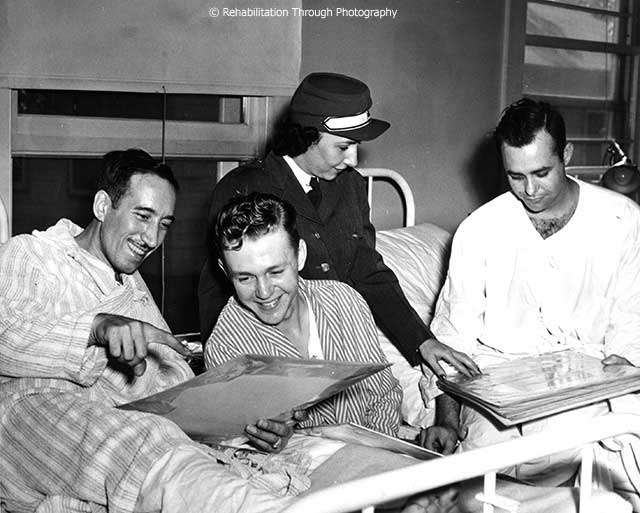There are a number of wonderful non-profit organizations that use photography to enrich people's lives. Over the years, we've heard from NYIP students who are involved in all kinds of laudable projects, and from time to time in the coming months we're going to look at some of those activities. We're starting with a project that's particularly close to our hearts at NYIP.
For over 70 years, the non-profit organization currently known as Rehabilitation Through Photography has been teaching photography to people with various kinds of needs and disabilities. This year, the organization is taking significant steps to rebrand itself and expand its services. Before we look at the latest developments, a recap of RTP's long and remarkable history is in order.
The organization began with a determined woman named Josephine Herrick. In 1941 she taught the first course in Defense Photography under the auspices of the War Service Photography Division of the American Women's Voluntary Services. Herrick learned photography by attending the New York Institute of Photography, so we're especially proud of her efforts.


When the U.S. joined World War II after the December 1941 attack on Pearl Harbor, Herrick organized a group of volunteers to take photographs of servicemen who were bound for combat overseas prior to their departure on ships bound for the war zones. The purpose was to send photos of the departing soldiers home to their families with an attached personal note.
This was an attempt to keep families united and raise spirits. America's entry into the war brought a great deal of uncertainty to many families. Herrick started receiving moving letters from the families who had received the photos and notes from their departing loved ones, an example of the power of photography.
Herrick was invited to visit veteran hospitals by a rehabilitation pioneer, Dr. Howard Rusk, who would later found the Rusk Institute of Rehabilitation Medicine, which is now affiliated with the New York University Medical Center. As wounded soldiers returned to the U.S. for indefinite hospital stays, Rusk's idea was to teach photography as a unique form of therapy.
In 1942, volunteers were commissioned by the U.S. military to teach photography skills at over 50 locations around the country. Portable darkrooms were also designed so that bed-bound patients could also partake in the photography sessions as well as learn to develop and print the photos they had taken. In May 1944, War Service Photography began providing rehabilitation photography services at veterans' hospitals including St. Albans Naval Hospital and Brooklyn Naval Hospital in New York City. WSP's teaching and nurturing of veterans continued after the war and in1946, it incorporated as an independent organization named Volunteer Service Photographers (VSP).


Josephine Herrick served as VSP's Executive Director and guiding force. Over the next several decades VSP continued its work in veterans' hospitals during the Korean War and Vietnam War.
Herrick's volunteer and grassroots efforts became so well known that requests started pouring in from facilities serving terminally ill and emotionally challenged individuals. During this time, VSP expanded its focus to cover civilian hospitals, nursing facilities and one of the first civilian beneficiaries of VSP's photography programs was Memorial Hospital, which subsequently became Memorial Sloan-Kettering Cancer Center.
In 1982, the organization was renamed Rehabilitation Through Photography (RTP), reflecting this new mission. Since that time, RTP's focus has further expanded and continued to encompass senior citizen facilities, youth organizations, centers for the emotionally and physically challenged, homeless shelters, substance abuse programs and other disadvantaged groups. After Herrick's death, RTP was led for many years by Jean Lewis, who continued the work that Herrick had started. When Jean Lewis passed away several years ago, RTP found itself in need of new leadership and a vision to allow it to continue and expand its mission in the digital age.Today, the organization has taken a look at its current activities and has decided to make substantive changes. RTP is guided by a volunteer Board of Directors, headed by Jackie Augustine, a long time veteran of the photographic industry, and late last year Maureen McNeil was appointed Executive Director, bringing years of experience in the arts and non-profit management to the organization.


As Ms. Augustine observes, "For 72 years, this organization has helped transform people's lives and empower underserved adults and children by helping them vocalize, by giving them a voice through photography. Today, we get a lot of inquiries about rehabilitation, but that's just of small part of who we are. We're really about helping people from many different communities see the world differently." A couple of years ago, NYIP Student Advisor Chris Corradino and I dropped by one of RPT's programs for homeless and recently homeless people in East Harlem and made a short video of our visit.
Part of RTP's current initiative is to rename itself. It will shortly be known as The Josephine Herrick Project, honoring its founder, and making it clear that its photographic projects are not limited to rehabilitation efforts. "Along with our programs, we are going to expand our efforts into exhibitions and publications," notes Maureen McNeil. "I want to reach out to photo clubs, and start getting to know the photography community on another level. Our goal is enhancing lives through photography, and we want to get our students known for their talents rather than their disabilities."
To that end, the group is mounting an exhibition in April at the Callahan Center Art Gallery at St. Francis College, 180 Remsen Street, Brooklyn entitled Portraits of Courage: Photographs by Veterans at the Brooklyn Veterans Administration. The opening reception is Wednesday, April 3 and it's free and open to the public. Miriam Leuchter, the editor of Popular Photography magazine and a member of the group's Board of Directors, will speak, along with Brandon Stanton, director of humansofnewyork.com.
In addition to Augustine and Leuchter, the organization's Board includes a number of people with strong ties to the photography and arts community in the New York City area, and the coming months the Board will oversee many new developments.


At this time, there are several ways that individuals can assist in the good work that this non-profit organization does.
First and foremost, donations of any size are welcome. Non-profit organizations often look to foundations and corporations for support, but one of the criteria those groups use to assess the viability of any non-profit is a broad base of support among the community. The organization's website is now www.jhproject.org and any small donation will be extremely helpful. The site accepts donations via paypal and it's easy to make a contribution.
In addition, new or gently used digital cameras that capture 6-megapixel or higher files and other related photographic equipment is welcomed. That information can also be found on the organization's website.
We'll check back with the Josephine Herrick Project later this year and provide our readers with an update.
NYIP photography school is very proud to support this fascinating orginaization.






